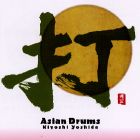|
Asian
Drums: Kyoshi Yoshida Compact disc. Pacific Moon CHCB-10013. Produced by Kazumasa Yoshikoa and Kiyoshi Yoshida. 1999. |
| Kiyoshi Yoshida is
listed as the primary composer/arranger/performer on "Asian Drums," a 1999
release on the Tokyo-based Pacific Moon label.
Yoshida’s compositional history is rooted in commercials, video games, pop music, and
television sound tracks. The press release for "Asian Drums" says, "his urge to capture his [Japanese] musical roots in some form grew stronger and stronger. He produced Asian Drums in 1999...to prove his identity and feature it in his music based on a frank acceptance of his Japanese heritage." Such a statement engages scholarly discourses on authenticity, and perhaps seeks to preempt any discussions of misappropriation on Yoshida's part. The sonic result is a combination of traditional Japanese musical elements and synthesizers. Neither this concept, nor Yoshida’s emphasis on taiko, a large Japanese drum, is particularly groundbreaking, although the execution is professionally done. The liner notes are filled with canonized, exotic descriptions of Japan and work to reconstruct a primordial and socially integral root for Japanese drumming. For instance, "it might be that our ancestors gathered to beat the Taiko whenever they wanted to convey something which could not be expressed with words, worship of the gods, prayer for a good harvest, and gratitude for nature's gifts." Pacific Moon, a division of Chapter One, positions itself as a purveyor of exotic sounds for the Western ear with record titles such as "East Wind," "Meditation," "Prayer," and "Ancient City." A website description of the company bears this out, stating, "throughout their history of four thousand years, the people of Asia have lived as one with nature, believing that man is intertwined with the universe..." In a clever marketing move, the CD jewelbox spine houses four sticks of incense with instructions on how to burn it. This album would most likely be found in a record store's "World Beat" or "New Age" section. It is perhaps not surprising that a review of a New Age CD would find its way to Ethnomusicology OnLine, since the scholarship of world music comments on, influences, and is influenced by popular music trends. |
|
"Rising Sun" opening |
The first track, "Rising Sun," exhibits a kind of intensity well-suited to a dark, action-movie soundtrack, no doubt with a high-kicking protagonist. The quick tempo provided by taiko group Wakon and the staccato shamisen (a plucked, three-string Japanese chordophone) of Shinichi Kinoshita use simple rhythms and melodies to create this aura (Audio 1). |
|
The remaining fourteen tracks maintain a similar atmosphere by combining the low, rumbling rhythm of the taikos with Yoshida's synthesized pentatonic melodies and washes of chords that seem to float in and out of the background (Audio 2). |
"Wave" opening |
Tracks 3, 6, 9, 11, and 13 are different because they present only traditional Japanese music, without the synthesizers. These are also the shortest tracks on the disc, averaging about a minute and fifteen seconds each. For instance, "Wave" (Audio 3) features Kinoshita playing solo shamisen. "Oiuchidaiko" (Audio 4) showcases Wakon performing a piece based on the "horsebeat" (dotted rhythm) used by many other taiko groups such as Oedo Sukeroku. |
"Oiuchidaiko" opening |
|
| In all, this is a well-produced disc that aligns itself with countless previous world beat recordings that combine the old ("primitive" or "authentic") with the new ("modern," "Western," or "synthetic"). | |
| Paul
Jong-Chul Yoon ...currently a graduate student at Columbia University. His current work focuses on the Korean American community in Flushing, Queens. Past work has addressed issues of Asian American and Japanese American identity with a specific focus on the New York City taiko group, Soh Daiko. EOL 6 reviews | email author | editor |
|
